Overview
Chief Scientists: Maya Tolstoy & Richard Allen
Dates: 10 July – 24 July, 2012, Seattle-Seattle
Objectives: Recover 14 LDEO TRMs; recover 10 LDEO OBSs; deploy 6 LDEO TRMs

Alternative OBS Recovery Method
Cruise Report and Fisheries Flyer
Team Diebold: Columbia undergraduates blog from sea.
Read the blog of Columbia University undergraduates that are participating in the cruise
Cruise Narrative
Semi-Daily updates prepared by two of the students on board
Cheng Cheng – UC Berkeley
Natsumi Shintaku – Brown University
Day 1: Tue July 10, 2012
Our cruse on the R/V Thomas G. Thompson started at 9:00 am from the University of Washington dock in Seattle. It takes about 12 hours to get from the dock out through the lock and into the Juan de Fuca Straight.
The R/V Thomas G. Thompson is owned by the office of Naval Research and operated under a Charter Party agreement by the School of Oceanography at the University of Washington. The Thompson is 274 ft in length, 52.5 ft. beam, and at full load has a 19 feet draft. The normal cruising speed is 11 knots, and offers a ships complement for 21 officers and crew, 2 marine technicians and berthing for up to 36 scientists.
Day 2: Wed July 11, 2012
We arrived at the first OBS station at about 1 am (lat: 47°54’, lon: 126°03’) after transiting for 16 hours. This instrument had been sitting on the ocean floor at 1798 m depth for the last year collecting data continuously. The retrieval procedure was initiated by sending a ping with a release code to the instrument. The instrument acknowledged the ping, released its anchor, and announced it was on it way up to the surface. OBS on the surface, OBS hooked, and finally OBS onboard. We had retrieved our first deep water OBS M03A …at about 2:45 am. A quick check showed that the data quality is good with teleseismic earthquakes clearly visible in the data. Then we left for the next deep water station J59A and arrived at it’s location (lat: 47°30’, lon: 126°24’) around 5:30am. After 2 hours of retrieving work we recovered our second deep water OBS J59A, which also contained more than one-year of quality data. We left for the third instrument of the day, J58A arriving at it’s location (lat: 47°19’, lon: 125°31’) around 10:30 am. We retrieved our third deep water OBS J58A at about 11:30 am. Again, good quality data. We then headed for the Jason Testing site (lat: 46°74’, lon: 125°22’) and arrived at it around 3:00 pm. During the travelling time, we were all trained to be watch standers in the Jason control van. Jason is an ROV designed for a range of scientific experiments and operations on the sea floor. Prior to starting the Jason test we decided to do a test of a new heave compensated winch intended to deploy and recover the shallow-water OBS instruments (the LEDO-TRMs). During the test, one of the TRM hoods was lost to sea when a line broke. The Jason test then doubled as a rescue mission for the TRM hood, which continued into Day 3. All of the students on the cruse (there are 7 total, five undergraduates and the two graduates students preparing these updates) are acting as Scientific Watch Standers. We are all on a 4-hours-on 8-hours-off watch rotation with three watches just like the rest of the ship. While on watch we monitor a variety of instruments including the swath mapping system and a chirp sediment profiler.
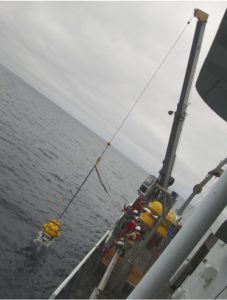
Retrieval of the deep water OBS
Day3: July 12, 2012
Our day began with the continued search for the lost TRM (Trawl Resistant Mount) hood from the previous day. The Jason test, which doubled at a rescue mission started with calibration of all the navigation gear, a process that involved putting a beacon in the sea floor and locating it from the ship in a variety of positions. The prep for Jason’s dive began at 01:00, and Jason was deployed in the water at 02:00. At 03:13 the TRM was found just 20 m from when Jason bottomed on the ocean floor. A temperature sensor for Paul Johnson was deployed on the ocean floor at the location of the test beacon at 04:12. The mooring will be recording the temperature of ocean water 1 m from the bottom for the coming year. After releasing the beacon from the floor, Jason—and its ship-tethered partner Medea—started their assent towards the surface at 04:30, paused at 200 m deep at 05:00, and Medea was out of water at 05:43. Medea was re-launched with a bridal attached for the TRM hood and was back on the sea floor at 06:26. The sonar was set to relocate the TRM hood at 07:37. Ten minutes later, the TRM hood was spotted and work began to attach the bridal coupling it to Medea. The TRM hood left the seafloor heading to the surface at 8:50, was hung below the ship’s fantail, and then separated from Medea. Medea was pulled up on the deck at 10:00, followed by Jason at 10:14. The TRM hood was finally winched onto the deck at 11:03 and we left the testing site a few minutes later. Next stop, J49A (46ᵒ 43.7460’N, 124ᵒ 42.4815’) arriving at 14:32 to recover our first real TRM. This one had been sitting on the ocean floor for a year at just 120m depth. The shallow water depth meant that a float on a line within the hood could be used to recover the instrument, when it works. The signal to release the float was sent at 14:45, but no float appeared on the surface. After searching for an hour we decided to move on to the next site (J41A) for the second TRM recovery. We would return to J49A and use Jason later. We left from the site J49A at 16:00, and arrived at the site J41A (45ᵒ 48.7316’N, 124ᵒ 32.1729’W) ~19:00. The signal to release the OBS was sent at 19:12, and the buoy appeared a few minutes later. The line was attached to the winch and we had the TRM on board at 20:24. At 20:35, we left J41A to return to the previous site, J49A, to recover the TRM with Jason. The ETA for the site J49A was shortly after midnight. The ship began to sway more as midnight approched….
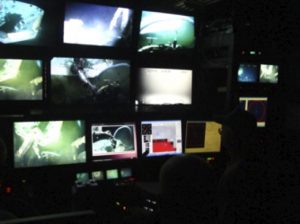
The scene inside the Jason control Van as the pilot is attaching a line to the TRM hood
Day 4: July 13, 2012
We returned to site J49A (46.43780 N, 124.42750 W) at 23:45 on July 12. This is the site where the buoy did not release so we needed to return when Jason was ready to dive. Jason was over the side at 01:02, followed by its partner Medea at 01:05. We began the search for the TRM in 120 m depth using Jason’s sonar at 01:45. After navigating around a large rock that was providing a great habitat for sea life (see photo)—and also a “hang” preventing trawling—we found the TRM waiting for us. Its buoy release had jammed closed due to bio fouling. As we approached the TRM a large fish emerged from inside the frame so we will need to watch for “fish bumps” on the seismic data (see photo). Jason poked the release and the float rushed to the surface at 03:16. The ship began the process of recovering Jason and Medea at 03:37. Medea was on board at 04:07, but the process of getting the TRM onboard continued until 07:20. At 08:25, we left site J49A heading for site M18B (44.88740 N, 124.97130 W), arriving at 16:00. However, the preparation of the TRM continued for some time and deployment only began around 21:10. The TRM hit the water surface at 21:15, and it reached the bottom at 21:40. At 22:30, it was confirmed that the TRM was deployed successfully following communication with the instrument on the bottom. The ship then started its circuit around the TRM at a distance of 300 m to survey its precise location. Then off to J33B for a side-by-side deployment using Jason.
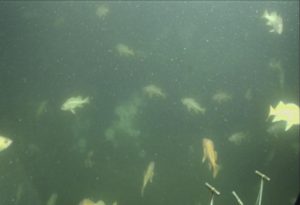
Sea life surrounding the large rock providing a “hang” for trawling nets and also protecting our TRM (Trawl Resistant Mount) from trawling.

Fish emerging from the TRM (Trawl Resistant Mount)
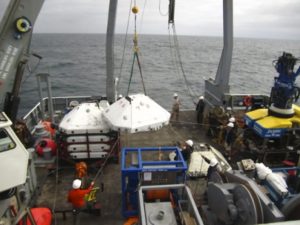
Preparing to deploy TRM (broad white cover) by winch.
Day 5: July 14th, 2012
Today began with the deployment of the TRM (Trawl Resistant Mount) at site J33B (45°06’N, 124°34’W). The plan was to deploy it using Jason. The reason being that there was a Scripps’s Abalone instrument that had been placed at this site last year. Just like the TRMs, the Abalones are new instruments designed for shallow water deployment. Having the two instruments next to one another would provide a rare opportunity for side-by-side comparison of the data. They should be next to one another for about one week. The students left the main lab and moved to the Jason Van as watch standers to witness the exciting deployment. By 13:43 Jason, Medea, and the TRM tethered below Medea were in the water. Having the TRM on the end of the line is a challenging way to deploy as the heave of the ship causes the TRM to be pulled up and down by up to 5 meters. This causes it to swing wildly and even flip upside down as the larger waves roll past. After cautiously approaching the TRM, dangling below Medea, with Jason, the TRM was lowered the final few meters to place it on the ground. On the first attempt the TRM ended upside down. A second attempt was made by winching up, and then down, in sync with the swell. Success, the TRM was now down and was the correct way up at 15:00. The TRM was located about 5 meters from the Abalone, and the two could be seen side-by-side with the Jason camera. Jason them moved close to the Abalone to check on its status. All looked fine with no evidence of trawling or other damage to the instrument. At 16:30 Jason and Medea began their assent up off the ocean bottom arriving at the surface half an hour later. We then headed towards the next site, J25B, which is the second location where two instruments would be side-by-side, arriving at 20:40. This time the engineers decided to use a new deployment method, which is intended to remove the effect of the ship’s heave. The TRM was attached to a string of floats for a controlled free fall to the bottom. Design and engineering of the string of floats began at 21:00 and lasted through the end of the day.

A view, from Jason, of the two instruments on the ocean floor about 5 meters apart. The white Lamont TRM is on the left, the Yellow Scripp’s Abalone is on the right.
Day 6: July 15, 2012
Yesterday ended with the preparation of a string of floats that would be used to free-fall drop the TRM station to the ocean floor. After about 5 hours of preparation, at 01:53, the TRM was released over the side with floats attached. The TRM began its decent to the seafloor at 02:00, but it was not until 02:56 that it was again captured by Jason’s camera. This is the second site where there was already a Scripps Abalone that had been on the ocean floor for about a year. The plan was to use Jason to pick up the TRM, with its string of floats, and move it close to the Abalone so that data could be compared for the few days that they were side-by-side. Jason first cut away some of the weights that were attached to the TRM to ensure negative buoyance for the descent. Jason then tried to pick up the instrument, but it was too heavy to move. More weights were cut and another attempt made, still no luck. The TRM was left unmoved; about 150 m from the Abalone. Jason then maneuvered over the sea floor to find the Abalone at 05:18. A quick survey showed that all looked good, and Jason took off from the seafloor at 5:27 to return to the surface. Jason was secured on board at 06:07, and the floats were released from the TRM at 6:30 and recovered back on board. From this test, we learned that a deployment using floats is probably preferable given that there is no longer heave causing the TRM to flip during decent on the end of the winch line. However, at the same time there is the potential for the TRM to drift in the current making it more difficult to hit a specific target location. We left site J25B (44.47265N, -124.57079W) at 07:00 heading for J26A (44.65470 N, 125.46638 W). There were rough seas on this transit, up to 15 foot swells which prevented the multibeam swath bathymetry system from collecting good data for some periods of the morning. At J26A we were to recover a deep water OBS instrument at the end of its one-year deployment. We arrived on site and issued the release code at 10:11. The OBS was on the surface at 11:31, taking about 80 minutes to travel the 2864 m from the sea floor to the water surface. Having craned the instrument aboard, we left J26A at 11:46 and headed to J17B (43.7877ᵒ N, -124.61330ᵒ W). While we arrived at the site at 17:58, preparation for deployment was not complete and continued. The float method was selected again, and the TRM, with floats attached was placed in the water at 20:08. The TRM drifted to the bottom, rather slowly at a fare of a few meters per minute. At 20:54, once it had been confirmed the TRM was on bottom, the floats were released and they were out of water at 21:06. We left from the site J17B at 21:30 heading for the next station, M10B (43.61360ᵒ N, 125.05160ᵒ W), while securing the floats. The ETA for the station M10B is 00:30 at the moment.
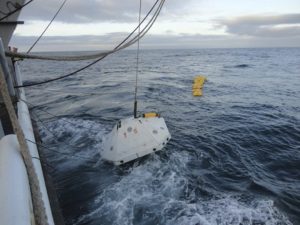
The TRM being deployed with floats at J17B.

We tested the deployment method, using floats. The picture shows the floats connecting to the TRM.
Day 7: July 16th, 2012
The day started with the deployment of M10B (43.61360ᵒ N, 125.05160ᵒ W). The TRM was to be deployed on a cable (rather than floats) to ensure that it was placed in the precise location recommended by fishermen. A small plateau, about 1 km across and slightly raised above the surrounding sea floor, poses a hazard causing nets to hang. The fishermen therefore avoid the area making it an ideal location for a TRM. Nets are also known to be stranded at the southern end of the plateau, so the TRM needed to be on the northern side. We arrived at the site at 00:30. The multibeam swath bathymetry indicated that the planned location was still on the southern side of the plateau so we slowly moved north until we had identified the right spot. The TRM was in the water at 02:07. The multibeam and the chirp sediment profiler was turned off so that we could communicate with the TRM as it was lowered to the sea bed. The TRM was on the bottom at 02:40 at a water depth of 674 m. By 02:56 the winch had recovered all the line and the acoustic release was back on deck. The final step was to survey for the precise location of the TRM by driving on a circular track 300 m from the estimated location. By sounding to the TRM the precise location could be triangulated.
After the deployment of this site was finished, we started our transit to the next site, M09B (44.250138ᵒ N, 125.060085ᵒ W, depth 914m), surveying some interesting landslide features on the way. A pod of dolphins followed along for a portion of the transit – great photos (courtesy of Barry Troutman). We arrived on site at 14:44 and started the process of winching the TRM to the sea floor on the end of a cable. The TRM was successfully deployed, and we started our 300 m circle to survey the location of the site at 16:31.
At this point in the cruse we have successfully deployed all 6 TRMs using a variety of approaches. We are now starting our transit to site J34A for recovery of regular deep water OBS. ETA on site is 23:30, and assuming the OBS is alive and releases its anchor, ETA of the OBS at surface is ~00:35 tomorrow morning.

Deploying a TRM using the winch

Dolphins following the ship for a portion of our transit. Photo by Barry Troutman, one of the marine mammal observers on board
Day 8: July 17, 2012
Yesterday ended at site J34A (45.30565ᵒN, 125.29973ᵒW), waiting for the deep water OBS to come up to the surface. After spending just over an hour rising through the 2574 m water column it was spotted on the surface at 00:34, and secured on deck at 00:52. We left the site on a heading for M06A (45.52947ᵒN, 124.92684ᵒ W) doing a bathymetry survey and also some testing of a new winch for Jason on the way. We arrived on site at 07:14 ready to retrieve another deep water OBS from 1438m depth. The OBS was pinged, responded, and began its ascend at 07:22. Rising at about 40 meters per minute, it was spotted at the surface at 08:00 and recovered on deck. The ship turned and headed for J42A (45.93305ᵒN, -125.29973) at 08:14, while OBS was being secured. We arrived at 10:40 to recover our third deep water OBS for the day. The OBS was spotted on the water surface at 11:20, was craned on deck at 11:34, and we were underway to the next site at 11:39. Next, site FN18A (46.69980ᵒN, 124.72480ᵒ W) which was in 163 m of water and had a pop-up buoy meaning that it needed to be recovered in daylight in order to spot the buoy at the surface. We arrived at 15:48 after transiting for over four hours. At 16:02, the release code was sent to the TRM, and the buoy was spotted at the surface just a few minutes later. The ship came alongside the buoy to recover it, and the attached line back to the TRM. The line was attached to the winch, and at 17:30 we started to recover the TRM. Shortly after getting tension on the line, all tension was lost indicating that the line had snapped and the TRM had returned to the bottom. Recovery using a line is proving to be challenging. This is primarily due to the heave of the ship, which in turn is due to the swell. As the ship pivots up and down the line experiences snap loading placing huge tensions on the line, and the swells were high during the recovery of FN18A. With the line broken, the Jason team was scrambled to recover the instrument. The site was surveyed to get an accurate location on the stranded TRM. Jason and Medea dived at 19:15 reaching the seafloor at 19:27. It was not until 20:49 that Jason spotted the TRM upside down on the seabed following its fall. Next, Medea needed to be moved into position above the TRM so the bridal hanging beneath Medea could be hooked to the TRM. Medea is on the end of a line from the ship, so the ship must be carefully maneuvered into the correct position. At 21:19, ten minutes after getting the bridal in the correct position, Jason had the bridal hooked to the TRM. Jason left the seafloor at 21:39, and was held at 70 m while the recovery team was readied. Medea was out of water at 21:57, followed by Jason at 22:09, followed by the TRM at 23:04. All was secure on board at 23:08 concluding a successful recovery and the end of the day.
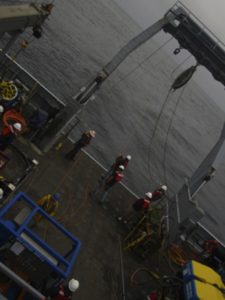
The first attempt to recover FN18A using the pop-up buoy/line and the winch.

FN18A was later located up-side down on he sea floor by Jason.
Day 9: July 18th, 2012
Today was neither the most successful nor lucky day of our trip so far. The first site of the day, FN09A (46.3393ᵒ N, 124.8853ᵒ W, depth: 190m), was expected to be an easy Jason recovery. Jason was in the water at 02:30, the instrument was located, hooked, and pulled up to 100m depth. Everything was going well. Then the swells started to increase causing a 9 m heave on the line with Medea and the TRM dangling at the bottom. As a particularly big swell came by, the bridal connecting the TRM to Medea snapped, and the TRM fell to the bottom. Based on the acoustic response—and consistent with past experience—it landed upside down …like this By the time Jason was back on board, the swells were so big that there was no way for Jason to dive again for a second attempt. So we decided to move on, and we will return to FN09A when the swell has subsided. Jason was out of the water at 04:30, and the ship turned towards OBS site J51A (46.4777ᵒ N, 126.0986ᵒ W, depth: 2606m). The deep-water OBSs float to the surface, so these instruments can be recovered in rough seas. After a 5 hour transit we arrived on site at J51A, sent the release signal at 09:30, and had the OBS on deck at 10:30. As this was one of the deepest water sites, we then did a CTD (Conductivity, Temperature, Depth) profile of the water column. The CTD is a sensor package that is lowered on a wire from the ship to the sea floor. This data is used to calibrate the temperature sensor in the OBS. By dong it at a deep-water site, where the temperature gradient at the bottom is small, the CTD data provides the best calibration. Lowering it down takes some time, but we get a temperature, oxygen and salinity curve as a function of water depth down to the bottom. We finished it at 13:37 and then started our transit back across the continental shelf to TRM site FN05A (46.5149ᵒ N, 124.3938ᵒ W, depth: 126m). The forecast had the swells subsiding so we should be able to retrieve a TRM on a line by the time we arrived. We were on station at 18:36 for our shallow water TRM recovery using a pop-up buoy. The TRM responded to the release signal and the buoy was spotted at the surface. The ship moved into position to recover the buoy and begin the process of pulling in the line. Unfortunately, the line got caught on something under the ship, potentially the propeller. After some assessment of the situation, we got the TRM line back on the winch and hauled up the TRM. The TRM was on deck at 20:53. Once all was secured on deck, we headed back to FN09A, arriving on site at 22:06. We started with a survey to identify the (new) location of the dropped TRM. Jason is now being readied and the dive will likely continue past midnight and into the morning…
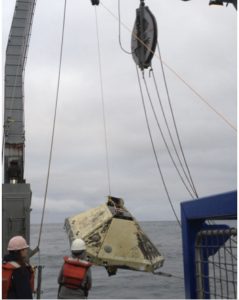
Recovery of the TRM at FN05A. The TRM was finally recovered after catching the line in the screws.
Day 10: July 19, 2012
Today began with preparation for a Jason dive on site FN09A (46.84010ᵒ N, 124.88770ᵒ W) having arrived at 22:06 last night. This was our second dive at this site. Yesterday the bridal connecting the TRM to Medea snapped on the way to the surface due to large swells. Jason was in the water at 00:40, and the TRM was spotted on the bottom at 01:11 …upside down. At 02:47, a line was hooked to the TRM successfully. Medea was on board at 03:38 followed by Jason. The TRM was out of water at 04:14. After the successful re-recovery, we headed to site FN10A (46.89780ᵒ N, -124.99360ᵒ W) to recover another TRM and deploy a thermal blanket. We arrived on site at 05:20, and Jason was deployed in the water at 06:25, followed by Medea at 06:30. At 07:04 Jason reached the muddy seafloor. The thermal blanket was deployed at 08:15. It will be recording heat flow from the seafloor for this coming year and will then be recovered. The TRM left the seafloor at 08:46 after it was hooked onto the bridal beneath Medea. Medea and Jason were out of water at 09:32, and TRM was secured on board at 10:07. After two successful overnight recoveries of shallow water TRMs, we headed to the site FN07A (46.85550ᵒ N, 124.78650ᵒ W) to recover a TRM with a pop-up buoy. It was only an hour transit. On arrival we sent the acoustic release code to the TRM. The TRM responded, however, no buoy could be found at the surface. After a failed search we decided to move on to the next site and return with Jason later. Next site, FN06A (46.92230ᵒ N, 124.73160ᵒ W), just a 30 minute transit away to recover another TRM with a pop-up buoy. We arrived on site at 12:10 and issued the release command; the buoy was on the surface within a minute. The buoy was recovered on the ship and the line hooked up on the winch. This recovery went very smoothly and the TRM was on the deck within half an hour. We left FN06A at 13:31 and transited back to site FN07A to confirm that the buoy was not floating on the water surface. The R/V Langseth was planning to shot a line over the site that evening, so it was important there was no buoy or line to catch in the Langseth’s streamers. No sight of the buoy. We continued on to site FN19A (46.72980ᵒ N, 124.367810ᵒ W), and our third pop-up buoy for the day. The release code was sent and acknowledged at 16:49, but the buoy did not appear at the surface …our second failed pop-up buoy for the day. It was 17:15 and we were on to the next site, FN01A (46.88200ᵒ N, 124.33370ᵒ W), our fourth pop-up buoy for the day. At this site, the TRM did not respond at all to our acoustic messages…so no pop-up buoy. We left FN01A at 18:50 heading to FN14A (47.02480ᵒ N, 124.96470ᵒ W) to start our Jason recoveries for the night. FN14A had a TRM at 173 m, too deep for pop-up buoys so this one would need Jason. The recovery at this site went very smoothly. We arrived on site at 21:10, Jason was in the water at 21:37, followed by Medea at 21:41. Jason reached the seafloor at 22:00. On the way to the TRM Jason was attacked by a swarm of krill – see photo. The TRM was soon located, hooked, and left the seafloor at 22:37. Medea was brought out from the water at 23:04, followed by Jason at 23:14, and TRM at 23:37. So, our summary for the day: we attempted to recover four pop-up buoys, but only one was successful. However, the recoveries with Jason were all successful retrieving a total of three TRMs. That makes a total for 4 TRM recoveries today. More Jason dives where planed for the night.
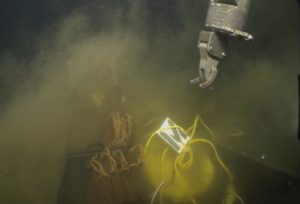
The muddy seafloor on site FN10A, captured by Jason camera. The yellow device is the thermal blanket that Jason deployed at this site.

The TRM at FN14A surrounded by a swarm of krill …the reason that so many whales were seen in this area.
Day 11: July 20th, 2012
We are now at the point where we need Jason to recover all of the remaining TRMs as they either did not have pop-ups, or their pop-ups did not pop. This includes two that are known to be upside down. They are all in the dense focused array so it only takes 30 minutes to an hour to get from one site to the next. We started with site FN12A (46.88850ᵒ N, -125.11920ᵒ W), which was a 655m “simple” site meaning that there were no know failures, i.e. it was the right way up and did not have a failed pop-up buoy. We arrived there at 01:00, and Jason was in water at 01:17 followed by Medea. The TRM was spotted at 02:25 and another thermal blanket was deployed adjacent to the TRM at 02:30. The instrument was hooked and Medea and Jason were successfully pulled out of the water at 03:32. The TRM was more resistant to coming on board, but was finally secured at 04:23. In order to take a break from the TRMs and allow the Jason crew to sleep, we then headed for OBS site FN16A (46.79960ᵒ N, -125.51614ᵒ W)—where the instrument should float up to the surface—and arrived at 06:15. This one was thought to be an “easy” site. We issued the acoustic signal and the OBS acknowledged, but it did not start to float up to the surface. Still, at 07:30 the OBS was showing no sign of reducing its range to the ship and was therefore still attached to its anchor on the sea floor. One more for Jason to recover later in the cruise! We headed to J50A (46.64016ᵒ N, -125.29905ᵒ W), another deep water OBS at a depth of 1904m. The recovery process went much more smoothly. The release signal was sent at 08:53, the OBS started its ascent to the surface, and came on board at 10:00. Now back to the TRMs. We transited to the 154m deep FN07A (46.85555ᵒ N, -124.78650ᵒ W), which has a pop-up buoy that did not release earlier. The plan was for Jason to shake the pop-up buoy loose and recover the TRM on its line. Jason was in the water at 12:24, and the pop-up was shaken free at 13:41. The buoy was recovered and the TRM was winched on deck at 14:52. Next stop another failed pop-up at FN19A (46.72980ᵒ N, -124.36710ᵒ W) that required Jason to shake the buoy free. It was extremely shallow at just 75m. Jason dived at 17:07 and released the pop-up buoy using a knife at 18:28. The buoy came up right beneath he ship resulting in a danger that the line might get stuck on the screws. The small rescue boat was launched and sent to grab the buoy and pull it away from the ship. Jason, Medea, and the TRM were all recovered on deck by 20:13. No line in the screws. The last one for the day was another TRM. FN03A (46.88680ᵒ N, -124.52510ᵒ W) was at 90m depth and its acoustic release indicated that it was upside down at the time of its deployment last year. Jason dived at 22:12 and found the TRM upside down surrounded by a lot of big fish. It was hooked to Medea and is on its way to the surface as the day comes to an end.
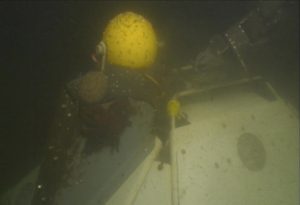
On site at FN19A. Note the red star fish and barnacles. Jason is prodding the buoy release mechanism to release it.
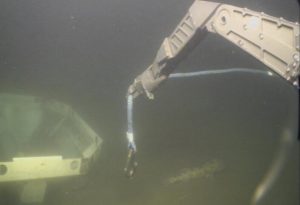
On site at FN03A which was upside down. The Jason arm is approaching the TRM with the hook.
Day 12: July 21, 2012
Yesterday ended with Jason and its counterpart Medea on their way to the surface at site FN03A (46.88680ᵒN, 124.52510ᵒ W). Medea was brought on deck at 00:11, followed by Jason at 00:20, and the TRM at 00:58. We started our transit back to the deep water OBS at FN16A (46.79960ᵒN, 125.5164ᵒ W) at 01:00. When we tried to recover this OBS earlier in the cruise, it responded to our acoustic signals, but did not come up to the surface. The plan was to check on its status and make sure that it had not later released and was now drifting away. On arrival this time the OBS responded to our ping. It was still on the bottom. We re-sent the release command and this time it started its rise to the surface. The OBS was on board at 05:26—one less for Jason. Now, back to site FN01A (46.88200ᵒ N, 124.33370ᵒ W). In transit to FN01A, we observed several possible columns of methane bubbles in the water. Some of them were directly over sections of the seabed where the sedimentary layering had been disrupted as if by the escape of the methane. These have been seen in this area before, but we are now seeing them on many of the short transits from one focused array site to the next. On to FN01A. This was the one TRM that did not respond at all to our acoustic messages. We began surveying the area immediately around site FN01A looking for a shipwreck that was marked on the charts. We used the multibeam and sediment profiler but were not able to find any signal associated with the wreck. This at least meant that it could not been too big which was important to know before Jason started to dive. Jason was in the water at 10:47, and reached the bottom at 10:51; the depth of this site was only 54 m. This also meant that the visibility was terrible as all kinds of life was floating around in the water. We found the TRM quickly, at 11:03, and then needed to decide how to retrieve it. The low visibility meant that it would be very difficult to find the bridal beneath Medea and hook it onto the TRM. The plan that formed was to attach reflective float on the bridle so it could be found by sonar. Jason and Medea were re-deployed with the modified bridle at 13:00. The TRM was hooked at 14:33, and was brought up on deck at 15:25. We left from the site FN01A at 15:30 after being on site for about 5 hours. More methane bubbles were observed while underway to the site FN08A. We arrived on site at FN08A at 17:43 to recover the last TRM for this cruise. The TRM was sighted at 19:02, was hooked, and left the seafloor at 19:50. Medea was out of water at 20:10, followed by Jason at 20:20, concluding the last TRM/OBS recovery for the Cascadia experiment on this cruise. We left from the site at 20:42, and are now heading to a WHOI OBS (47.81251ᵒ N, 126.47085ᵒ W) that was lost during a previous experiment to study the Juan de Fuca ridge. The hope is that we will be able to find and recover it with Jason. ETA 08:00 tomorrow.

A float attached to the Medea bridal to make a good sonar reflector so that the bridal could be found in the biota-filled waters of FN01A.

The TRM being secured on deck following recovery at site FN01A. This was our sunny day!
Day 13: July 22nd, 2012
Today is the last day of our cruise before heading back into Seattle. Today we need to rescue the WHOI OBS (47.81251ᵒ N, 126.47085ᵒ W) which was deployed several months ago as part of another research project. Having Jason on board means that we have a chance to locate the lost instrument on the sea floor and bring it back to the surface. If our rescue is successful, our recovery rate will be 104%! We arrived on site at 08:00 at the location that the lost instrument was last seen. This is a deep-water OBS (2235m) rescue mission and will be the deepest dive for Jason on this cruise. Jason was in the water at 08:17 followed by Medea and the couple travelled to the bottom. As a result of the depth, they did not reach the bottom until 09:37. As Jason began his search, the team on the ship continued to ping the instrument. Then, it suddenly responded. Five minutes later it released and was on its way to the surface arriving at 11:00. It took Jason and Medea considerably longer to return to the surface and they needed to be recovered before we could pick up the OBS, but all were back on board two hours later. So, we have now recovered all the instruments we can out to collect, plus an additional rescue. Our recovery rate is indeed 104%!
We have also has a chance to review some of the seismic data from the instruments collected. Below are a few record-section plots for a teleseismic and a local earthquake. Figure 1 shows seismographs for a M6 earthquake on the Blanco Fracture Zone (2.33ᵒN, 93.063ᵒ W). We can see clear P-, S- and surface-waves recorded by the TRMs and OBSs. The figure also includes three on-shore stations for comparison. Figures 2 and 3 are the teleseismic seismograms for the M8.6 Indonesia Earthquake (43.58ᵒN, -127.638ᵒ W). Figure 2 shows the complete waveform, while Figure 3 zooms in on the P-wave arrivals. Again, the seismograms compare very well with the ones recorded by the three on-shore stations.
On our long transit back to Seattle we stopped at Neah Bay (48.23076ᵒN, 124.347562ᵒ W) just inside the Juan de Fuca Straight to do an ROV test. The LDEO OBS crews on board have a small ROV that they want to test for use in future OBS deployments. We arrived on site at 20:00 and ran the test until 21:40. Although being very small compared to Jason, the ROV was able to travel to the bottom and search around for objects. The idea is that an ROV like this might be able to support the future deployment of shallow water OBSs or TRMs. As we leave the test site heading for port, this is where our daily log ends. Done! We expect to be in port some time tomorrow.
Fig 1. Local Mw 6.0 earthquake on April 11th 2012 at 22:41:46 from the Blanco Fracture Zone at 43.5840°N -127.6380’W. Note the difference in the ratio between the P-waves and the surface-waves of the on-shore (WISH, HUMO, I02D) vs off-shore stations. Each waveform is scaled to its maximum amplitude, and stations are ordered by distance.
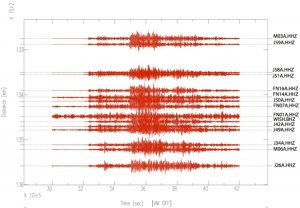
Fig 2. Arrivals from Mw 8.6 earthquake off Sumatra on April 11, 2012 at 08:38:36 (2.33°N, 93.06°E). Note that land stations are essentially indistinguishable from the seafloor stations. Each waveform is scaled to its maximum amplitude, and stations are ordered by distance. A band-pass filter of 10- 25 seconds was applied to the data.
Data





















